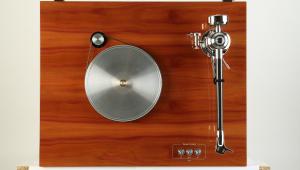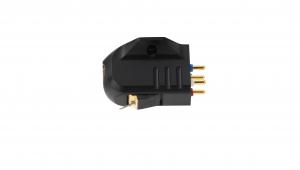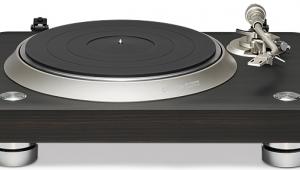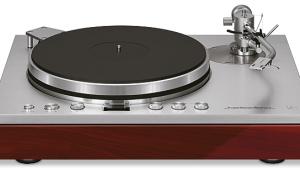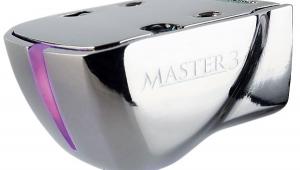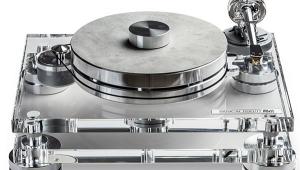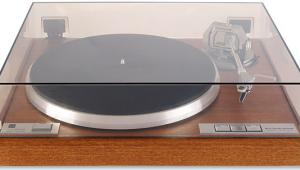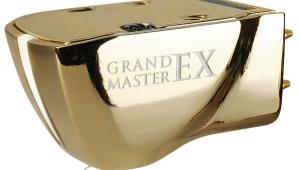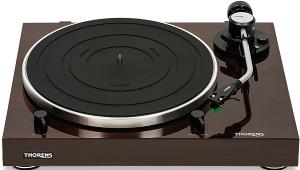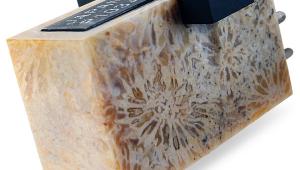Pro Ject Rpm 10.1 Evolution Turntable (£2000)
Bigger and fatter even than the RPM 9, which it otherwise resembles, the RPM 10.1 Evolution updates on the earlier RPM 10 with a better arm and other refinements. But the choice of materials is as important as the quantities of them. Pro-Ject’s Austrian founder and owner has been experimenting with different materials since the inception of the company 20 years ago. It was in February 1990 that Heinz Lichtenegger first drove over the border to visit the Czech factory which has continued to build turntables for Pro-Ject ever since. The earliest Pro-Ject budget models were based on the factory’s existing designs and parts, including a simple pressed-steel platter.
PLATTERS MATTER
The chassis sits on three adjustable coned feet, resting in special cups set into the face of the Ground It platform, which is made of medite with a ‘granulate’ mineral filling. In its latest version, called Ground It 3 Deluxe, this in turn floats on four
level-adjustable magnetic-repulsion feet. On top of all this you now get Pro-Ject’s priciest 10in arm, the 10cc Evolution, essentially an even more rigid and better-damped version of the 10cc model. In this case, the arm does not come with the usual cable and phono plugs, but is hard-wired to the turntable. The signal wires passing down through the arm pillar are soldered to the backs of the phono socket connectors, which can be seen looking out from a small metal housing below the plinth. Having balanced out the arm and set the loose marker disc to zero, you wind the weight forward further to dial the desired tracking force. I found the calibration accurate but felt the counterweight threading too loose for comfort, a bit too easily disturbed in handling.
TALL TALES
I found that Pro-ject’s record weight does help the solidity and precision of the bass, and makes the whole sound a little tidier. On some recordings you seemed to lose a little air and liveliness but I felt that the slightly looser, splashier weightless sound was less accurate. Serious listening started with the Ortofon Cadenza Blue, running via the excellent Moon LP5.3 phono stage [see HFN April ’10]. Immediately, Action: Oscar Peterson Vol 1 [MPS 68.073] seemed to reveal the key virtues of the turntable. Peterson and the trio kick off ‘At Long Last Love’ with an exuberance that’s audibly busting out all over before settling gracefully into the acoustic of the venue, but even here, where many systems become clangorously bright, the sound was smooth and never raucous. With the wild guitars of Eric Clapton’s ‘Motherless Children’ from 461 Ocean Boulevard [RSO 2479 118], there was even a slight feeling that the guitars weren’t quite wild enough, that the lid was being kept on. Carl Radle’s bass line was clearly portrayed, and yet the rhythm seemed almost sedate, rather than the headlong and exciting rush that it can be. The Pro-ject seemed happy to move on to the next track, ‘Give Me Strength’, where it shone, illuminating Clapton’s guitars and vocal with precision, detail and clarity. There were no complaints about the rhythm on the next album. ‘Sultans Of Swing’ from Dire Straits [Vertigo 9102 021] showed that the Pro-Ject could give both clarity and control, as Knopfler’s lead guitar had real power and magic, while his vocal enjoyed character and depth. At the same time, the tight and mobile rhythm was immediately arresting.
EPIC SOUNDS
A quick burst of Harry James and The King James Version [Sheffield Lab LAB 3] confirmed the Pro-Ject’s solid abilities at the bottom end, and its convincing stereo imagery. For example, the way the piano, though very much in the background, still had its own space and ambience. Brass was punchy yet never too fierce and the saxes sounded positively creamy. From the Ortofon I moved on to the Koetsu Black, perhaps a likely and attractive alternative for a deck in this price range. Predictably, perhaps, the Pro-Ject/Koetsu delivered a much more stirring rendition of ‘Motherless Children’ than the Ortofon’s. The slide guitar was loud and brash, a big, tearing sound, while Clapton’s vocal sounded almost majestic. Yet there was a sense of chasing detail that you couldn’t quite catch. Carl Radle’s bass had nothing like the clarity achieved with the Ortofon, but it drove the track along better. On ‘Sultans Of Swing’ the Koetsu again delivered passion, energy and vibrancy at the cost of subtlety, making this studio recording sound as if it was coming from some draughty, highly-electrified stage. It even seemed, subjectively at least, to up the tempo, with a beat that pushed ahead urgently rather than smoothly rolling on. With the Koetsu on ‘Easy Money’, it seemed the Pro-ject was doing its best to control the cartridge’s big bass sound, but it couldn’t avoid a somewhat overblown and even clumsy effect. This cartridge gave a breathier, more dramatic presentation of Rickie Lee’s vocal, while higher-pitched instruments like the celeste on this track became more prominent and tinkly. Few buyers of a £2000 turntable will stay with moving-magnet cartridges, but I was curious to see how the Pro-Ject would handle one of the best of the breed. With the Roksan Corus Black installed I went back to ‘Easy Money’, finding the bass well-controlled, even if it couldn’t match the firm clarity of the Cadenza Blue or the grunt of the Koetsu Black. Mid and treble were well detailed and nicely balanced, with stable stereo imagery. On ‘Sultans Of Swing’, the Corus Black sounded very good indeed, with fine detail in the percussion and great rhythm. I felt that this was an excellent result for a moving-magnet cartridge. And it surely proved that the Pro-Ject 10.1 Evolution must be doing something right. Probably most things!
VERDICT
Weighty but well-priced, this player vindicates Pro-Ject’s work on plinth materials, but what really makes it work so well is the high-grade 10cc Evolution arm. There is clean, deep bass quality that allows the rhythmic drive of the music to come through, solid but not heavy-footed. Giving an uncoloured and open midrange with fine imaging, this is a well balanced, vice-free package, and very good value.
Sound Quality: 80%
Originally published in the May 2010 issue






